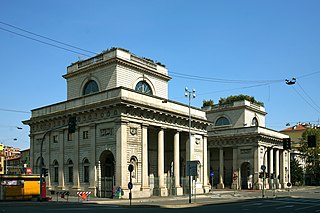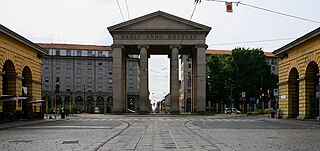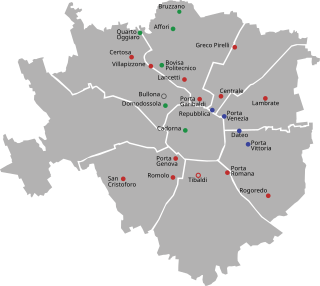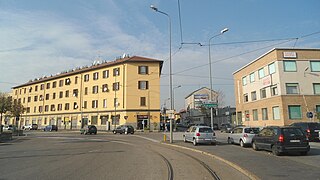The gate
A "Porta Lodovica", roughly facing the same direction as that of the Spanish walls of Milan, was already part of the city's medieval walls. It was located by the postern of Saint Euphemia. The gate was named after Ludovico Sforza because he had the idea of enlarging the former "Porta di Sant'Eufemia" to facilitate access to the Santa Maria presso San Celso sanctuary, which was visited by many pilgrims. An inscription on the medieval Porta Lodovica read: "Ludovico Maria Sforza opened this gate, named Lodovica after him, together with his wife Beatrice, so that that religious rushing up of his citizens to the house of Mary, Mother of God, be easier and shorter". [1]
When the medieval walls were replaced by the Spanish walls, the old Porta Lodovica was demolished and the new one was built.
In the late 19th century, when new districts developed in the periphery of Milan, several gates and several tracts of the city walls were demolished to make traffic easier. Porta Lodovica was demolished in 1905.

Monza is a city and comune (municipality) on the River Lambro, a tributary of the River Po, in the Lombardy region of Italy, about 15 kilometres north-northeast of Milan. It is the capital of the province of Monza and Brianza. Monza is best known for its Grand Prix motor racing circuit, the Autodromo Nazionale di Monza, which hosts the Formula One Italian Grand Prix.

Ludovico Maria Sforza, also known as Ludovico il Moro, and called the "arbiter of Italy" by historian Francesco Guicciardini, was an Italian nobleman who ruled as the Duke of Milan from 1494 to 1499.

Isabella of Aragon, also known as Isabella of Naples, was by marriage Duchess of Milan and suo jure Duchess of Bari.

The Sforza Castle is a medieval fortification located in Milan, northern Italy. It was built in the 15th century by Francesco Sforza, Duke of Milan, on the remnants of a 14th-century fortification. Later renovated and enlarged, in the 16th and 17th centuries it was one of the largest citadels in Europe. Extensively rebuilt by Luca Beltrami in 1891–1905, it now houses several of the city's museums and art collections.

Corso Buenos Aires is a major street in north-eastern Milan, Italy. With over 350 shops and outlets, it features the highest concentration of clothing stores in Europe. The architecture of the area is mostly late 19th- and 20th-century style; the street and its surroundings are pointed with several neo-classical and Art Nouveau buildings.

Porta Venezia is one of the historical gates of the city of Milan, Italy. In its present form, the gate dates back to the 19th century; nevertheless, its origins can be traced back to the medieval and even the Roman walls of the city.

Porta Vittoria was a city gate in the Spanish walls of Milan, Italy. While the walls and the gate have been demolished, the name "Porta Vittoria" has remained to refer to the district ("quartiere") where the gate used to be. This district is part of the Zone 4 administrative division of Milan.

Porta Romana is a former city gate of Milan, Italy. In its present form, the gate dates back to the 16th century Spanish walls of Milan. Its origins can be traced further back to the Roman walls of the city, which had a corresponding "Roman Gate" roughly in the same area. Porta Romana was the first and the main imperial entrance of the entire city of Milan, as it was the starting point of the road leading to Ancient Rome. According to a survey conducted by Scenari Immobiliari in 2020, this area is in first place in the ranking of the neighborhoods that offer the best liveability in Milan.
Morivione is a district ("quartiere") of the city of Milan, Italy, part of the Zone 5 administrative division, located south of the city centre. It is informally defined as the area enclosed within four streets, namely Viale Toscana, Via Ripamonti, Via Antonini and Via Bazzi. The district is especially associated to the celebrations in honour of Saint George, where Milanese people would traditionally drink milk and eat a kind of sweet called pan de mein.

Porta Ticinese is a former city gate of Milan, Italy. The gate, facing south-west, was first created with the Spanish walls of the city, in the 16th century, but the original structure was later demolished and replaced in the early 19th century. The name "Porta Ticinese" is used both to refer to the gate proper and to the surrounding district, part of the Zone 6 administrative division. In the same district there is also a medieval gate with the same name, although in common speech the name "Porta Ticinese" is usually assumed to refer to the 19th century gate.

Porta Magenta, formerly known as Porta Vercellina, was one of the city gates of Milan, Italy. The gate was established in the 9th century, with the Roman walls of the city; it was moved with the medieval and Spanish walls, and was finally demolished in the 19th century. The phrase "Porta Magenta" is now used to refer to the district ("quartiere") where the gate used to be; the district is part of the Zone 7 administrative division of Milan, west of the city centre.

Porta Volta is a former city gate of Milan, Italy, part of the Spanish walls. Nowadays, the name "Porta Volta" is most commonly used to refer to the surrounding district ("quartiere"), part of the Zone 8 administrative division of the city.
The city of Milan, Italy, has had three different systems of defending walls. The oldest, the Roman walls, were developed in two stages: the first in the Republican era and the second in the Imperial era. The second wall system was realized in the Middle Ages, after the destruction of the city by Frederick I Barbarossa. Finally, the latest wall system was built by the Spanish rulers in the 16th century. While very little remains of these walls, their structure is clearly reflected in the urbanistic layout of the city. In particular, modern Milan has two roughly circular rings of streets, namely the "Cerchia dei Navigli" and the "Cerchia dei Bastioni", which essentially correspond to the Medieval and Spanish walls, respectively. Note that a third ring of roads just beyond the Inner Ring Road, called the External Ring Road, does not follow any old city walls, but rather was part of the 1884 Beruto Plan for the city of Milan, created and named after a municipal engineer and public servant to the local city government.

Milan has 24 railway stations in use today. Of these, 18 are managed by RFI, while the remaining 6 are operated by Ferrovienord. Three more stations are currently in the planning stage for the city area: Canottieri, Dergano and Zama.

The Zone 1 of Milan, since 2016 officially Municipality 1 of Milan, is one of the 9 administrative divisions of Milan, Italy.

Viale Pasubio is an avenue in Milan, Italy. It is part of the circonvallazione interna ring road, a major traffic route that runs along the former Spanish walls of Milan. The street is 350 m long and connects two former city gates, namely Porta Garibaldi and Porta Volta. The street was formerly known as "Viale di Porta Garibaldi", and was renamed after World War I in remembrance of the fightings on the Pasubio massif (Dolomites) that occurred during the war.

The Medieval Porta Ticinese is a gate of the former 12th-century Walls of Milan; it is located at the intersection of the Corso di Porta Ticinese and Via Edmondo de Amicis and Via Molino di Armi in the city center of Milan, region of Lombardy, Italy. This is one of the three remaining medieval gates of Milan. The others are Porta Nuova and the Pusterla di Sant'Ambrogio.

Quartiere Varesina is a small district, quartiere, of Milan, located in the suburban north-west part of the city. It belongs on the Zone 8 administrative division of the city.

Visconti Park was the private park of the Visconti and Sforza families, lords, and dukes of Milan. Located in Lombardy, northern Italy, it extended between Pavia Castle and the Certosa di Pavia monastery. It covered an area of about 2,200 hectares (22 km2) and was encircled by walls about 25 kilometres (16 mi) in length. It was founded in 1360 by Galeazzo II Visconti and enlarged by his son Gian Galeazzo.

The Venetian walls of Crema are an architectural construction dating back to the second half of the 15th century, built for defensive purposes.


















